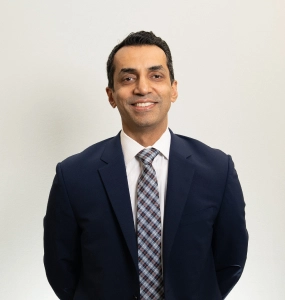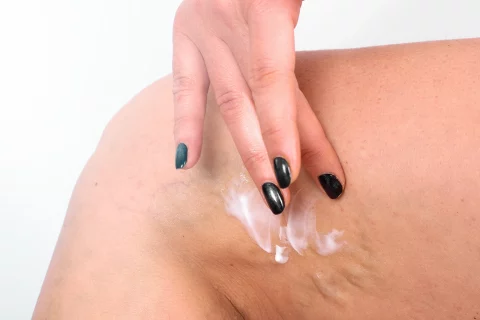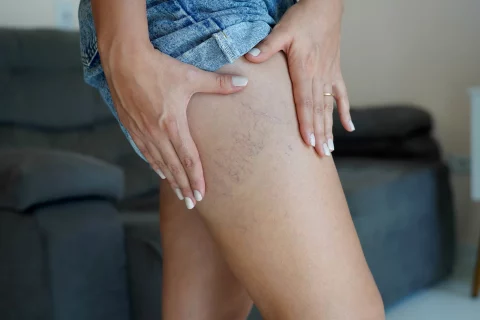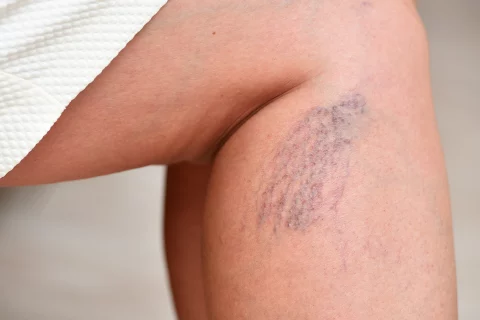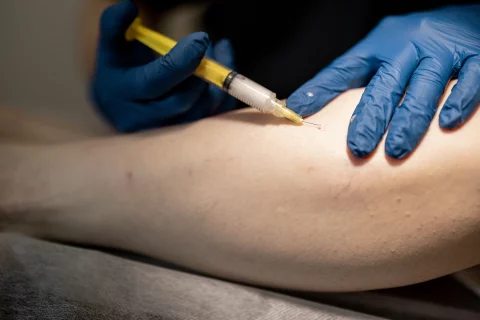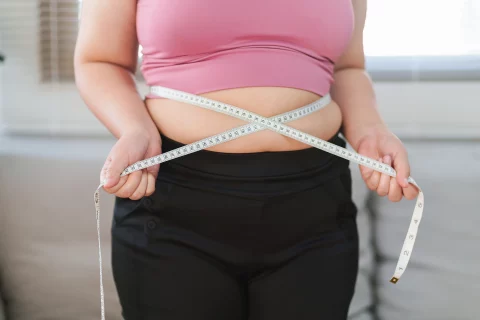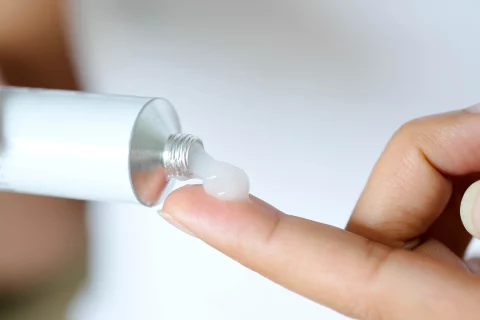
Spider veins are a common vascular concern that can affect men and women of any age. While larger spider veins and varicose veins tend to garner more attention, very fine spider veins present their unique challenges.
Even when they are not visibly pronounced, these delicate networks of blood vessels can cause discomfort, impact self-esteem, and potentially signal underlying medical issues.
Take the first step towards vein health. Visit our Vein Center Doctor to understand the best treatments for your fine spider veins.
What Causes Fine Spider Veins to Develop?
Fine spider veins, often referred to as telangiectasias, emerge due to the dilation and weakening of tiny blood vessels beneath the skin. They are usually less than 1mm in diameter.
A key factor in the formation of spider veins is the malfunction or deterioration of valves within the veins. These veins, which return blood to the heart, are equipped with one-way valves to prevent backflow.
When these valves are compromised, blood may struggle to flow properly, leading to pooling. This accumulation can cause the vein to expand and branch out, forming spider veins.
Facial spider veins typically result from the rupture of small blood vessels, often triggered by heightened pressure or damage from sun exposure.
Various risk factors have been identified in the development of spider veins:
Genetics Play a Big Role
Like varicose veins, genetics are thought to be the most common cause of spider veins. Individuals with a family history are at a higher risk of developing spider veins, even very fine threads.
The inherited weakness or malfunction of the valves within veins allows blood to improperly flow backwards and pool, causing veins to swell and become visible under the skin.
Age and Hormonal Changes
As we age, our veins naturally lose elasticity and the ability to efficiently circulate blood through the body.
Estrogen fluctuations during puberty, menstruation, pregnancy, and menopause may also promote spider vein development. The high levels of progesterone during pregnancy put significant pressure on blood vessels.
Prolonged Standing and Sitting
Jobs or daily activities that involve extensive standing and sitting can gradually exert pressure on the veins, impeding proper blood flow. This venous insufficiency and blood pooling can worsen over time if preventative measures are not taken.
Obesity and Weight Gain
Excess body weight stresses the veins and can contribute to valve dysfunction. Fatty tissue can also put direct pressure on veins.
Sun Exposure
UV radiation can damage the skin, including the blood vessels underneath. Over time, excessive, unprotected sun exposure can promote spider vein development.
Prior Injury or Trauma
In some cases, a prior injury near a vein can damage the blood vessel and surrounding tissue. Resulting inflammation and scarring may impair normal venous circulation.
How to Identify Fine Spider Veins

Catching fine spider veins early is important for prevention and treatment. Here are tips for identifying them:
Look for Tiny Red, Blue or Purple Threads
Fine spider veins often appear as tiny reddish, bluish or purple threads under the skin surface. They are comparable to the size of actual spider silk threads.
Common Locations Include Legs, Thighs and Face
Areas most prone to spider veins include the legs (particularly the thighs, calves, and ankles), as well as the face. Fine spider veins in these locations may signal risks like venous insufficiency.
Eyelids and Under Eyes are Susceptible
The delicate skin around the eyes is especially vulnerable to fine spider veins. They may be noticeable under bright light.
Discomfort Such as Itching, Burning May be Present
Unlike many large varicose veins, fine spider veins themselves are not painful. But they may be associated with sensations like itching, burning or tingling discomfort.
No Bulging Like Varicose Veins
Unlike varicose veins which protrude under the skin surface, fine spider veins remain flat and close to the skin. The only visible signs are their thread-like patterns.
Can Be A Sign of Underlying Conditions
While not directly harmful, very fine spider veins may indicate circulatory issues or health conditions like venous insufficiency, hormone disorders, or liver disease. Consult a vein doctor if you are concerned.
How Do Fine Spider Veins Differ From Varicose Veins?
While both result from venous concerns, fine spider veins, and varicose veins have distinct differences:
| Aspect | Fine Spider Veins | Varicose Veins |
| Appearance and Size | Tiny, measuring less than a millimeter in diameter. | Larger, bulging blood vessels. |
| Color | Reddish, purple or blue hue. | More blue or green. |
| Texture | Flat and close to the skin surface. | Twisted, bulging, and rope-like under the skin. |
| Symptoms | Mild discomfort like itching or burning. | Throbbing, muscle cramping, swelling, and heaviness. |
| Severity and Health Risks | Largely cosmetic with little health risk. | Indicate more advanced venous disease; can lead to complications if untreated. |
Consulting a vein specialist can help determine the severity and optimal treatment approach. Catching problems early maximizes treatment options down the line.
Preventing and Minimizing Risk of Fine Spider Veins
While hereditary factors play a major role in spider vein development, certain lifestyle measures can help reduce your risk:
Exercise Regularly and Stay Active
Moving your legs frequently enhances venous circulation. Simple ankle and calf exercises also keep blood flowing properly through the veins.
Maintain a Healthy Weight
Excess body weight taxes the veins. Shedding extra pounds can minimize pressure and venous reflux.
Avoid Prolonged Standing or Sitting
Take regular short breaks to walk around and stretch if your daily activities and job involve extended static positions.
Limit Heat Exposure
Don’t take over-hot baths, and avoid prolonged direct sun exposure or tanning which can degrade vein health over time.
Elevate Your Legs
Resting your legs higher than your heart level lets gravity assist with proper venous return. Do so for short periods daily.
Wear Compression Stockings
Special elastic compression stockings improve venous circulation and valve function, decreeing leg swelling and varicose vein flares. They can also help prevent new spider veins if worn daily.
Modern Treatments for Fine Spider Veins

Today’s minimally invasive treatments make eliminating fine spider veins easier and more effective. Common options include:
Sclerotherapy
Sclerotherapy is considered the gold standard for treating spider veins. It involves carefully injecting a liquid solution into the vein, which scars and closes the walls of the vein so blood gets rerouted to healthier veins. After several sessions, the spider vein is eliminated.
Laser and Intense Pulsed Light Treatments
Pulses of laser or other light energy can selectively destroy spider veins with minimal discomfort or downtime. The heat obliterates the unwanted vein, which the body then absorbs and discards over the following weeks.
Combination Approaches
For faster results, your doctor may combine sclerotherapy and laser energy. The laser weakens the veins, allowing the sclerosing agent to further scar and destroy the unwanted blood vessels.
Treatments are fast, ranging from 15 minutes to an hour. The choice depends on the location and extent of your fine spider veins. Your doctor will advise the best approach or combination to meet your needs and goals.
Managing Fine Spider Veins in the Long Term
While modern treatments can permanently remove fine spider veins, maintaining long term vein health through preventive care is also key. Follow these tips:
Get Regular Check-ups
Have a Vein Center Doctor monitor your veins every year to catch any new spider veins promptly when they are easiest to treat. Early treatment prevents progression.
Continue or Establish Healthy Lifestyle Habits
Stick with regular exercise, proper leg elevation, compression stockings, and other habits to support healthy circulation and vein strength. Maintaining an ideal weight also helps take pressure off your veins.
Know When to Seek Medical Advice
Consult a specialist promptly if you notice expanding spider veins or start experiencing pain or discomfort, which could indicate worsening venous insufficiency. Seek advice about the best treatment plan.
Consider Repeat Treatments as Needed
Depending on the severity of the original spider veins, repeat treatments may be recommended over time. Many patients require 2 to 4 treatments spaced several weeks apart for optimal removal of all the unwanted veins. Maintenance treatments as years go by may also be suggested to address any new veins that surface with age.
Be Patient During the Healing Process
It takes a few weeks for treated veins to fully clear from your system. Some residual redness or bruising around the injection sites is normal initially. Follow your doctor’s aftercare instructions to speed healing.
Embrace Healthy Lifestyle Changes
Take advantage of this opportunity to reassess your daily habits and routines to minimize risk factors that could cause new spider vein formation. Small healthy lifestyle tweaks can provide lasting benefits for your vein health.
Why Vein Specialists Are Ideal for Treating Spider Veins
Vein specialists possess extensive skill and experience addressing the full spectrum of venous concerns, from spider veins to chronic venous insufficiency. They can provide solutions tailored to your individual needs.
Expertise in Latest Treatments and Technology
Vein specialists stay current on the latest proven treatment methods and devices to safely eliminate spider veins with minimal discomfort and downtime.
Customized Treatment Plans
They develop customized treatment and maintenance plans based on your vein health history and goals. This provides optimal resolution of your spider veins.
Improved Long Term Vein Health Management
Beyond resolving the current veins, they also educate on lifestyle changes to improve circulation and prevent future spider veins or progression to varicose veins down the line.
Enhanced Diagnosis of Associated Health Issues
Vein experts can diagnose underlying causes or health issues that may be contributing to the spider veins, and advise on appropriate solutions.
Increased Patient Confidence and Reassurance
Their expertise and clinical experience provide reassurance and build patient confidence throughout the diagnosis, treatment, and follow-up process.
Wave ‘bye-bye’ to spider veins! Let our Vein Center Doctor zap them away. Book your ‘spider-free’ journey today!
Conclusion

Fine spider veins can be more than just a cosmetic nuisance. But today’s minimally invasive treatments offer impressive results removing these delicate networks of veins for improved appearance, self-confidence, and psychological well-being.
Combining these targeted procedures with lifestyle changes that boost long term vein health can help you achieve smooth, vibrant looking skin. Consulting a vein specialist is key for proper diagnosis and customized treatment of your individual spider veins.
FAQs About Spider Veins
Can wearing compression stockings prevent the development of spider veins?
Wearing compression stockings can help improve blood flow and reduce the risk of developing spider veins. They exert gentle pressure on the legs, aiding the blood vessels in circulating blood more efficiently, thus potentially preventing the progression of spider veins.
How does prolonged standing or sitting contribute to venous insufficiency and the formation of spider veins?
Prolonged periods of standing or sitting can hinder proper blood circulation, leading to venous insufficiency. This condition occurs when the veins have trouble sending blood from the limbs back to the heart, which can contribute to the formation of spider veins due to increased pressure in the veins.
Are people with a history of deep vein thrombosis (DVT) more likely to develop spider veins?
People with a history of deep vein thrombosis may be at higher risk of developing chronic venous insufficiency (CVI) and varicose veins. DVT can harm the vein valves or walls, causing poor blood flow and potentially leading to spider veins due to increased pressure in the superficial blood vessels. However, there is no indication that a history of DVT is specifically a risk factor for spider veins.
Can laser therapy be an effective treatment for fine spider veins?
Laser therapy is often an effective treatment option for spider veins, especially for those that are very fine. The laser energy targets the affected blood vessels, causing them to collapse and gradually fade away. This minimally invasive treatment is particularly useful for treating spider veins on the face and legs.
Do hormonal fluctuations during the menstrual cycle affect the development of spider veins?
Hormonal fluctuations during the menstrual cycle can impact the development of spider veins. Changes in hormone levels, particularly estrogen and progesterone, can weaken vein valves, leading to increased vein visibility and the formation of spider veins.
Can obesity increase the risk of developing both spider veins and varicose veins?
Yes, obesity can significantly increase the risk of developing both spider veins and varicose veins. Extra weight puts additional pressure on the veins, particularly in the legs, which can lead to valve dysfunction and the formation of both spider and varicose veins.
How does maintaining a healthy body weight contribute to healthier veins?
Maintaining a healthy body weight reduces the stress on the veins, especially in the lower body. Less pressure on the vein valves facilitates better blood flow, helping to prevent the weakening of veins and the development of venous conditions like spider veins.
Are there any specific environmental factors that can exacerbate the risk of spider veins?
Certain environmental factors, such as prolonged exposure to the sun or extreme temperatures, can exacerbate the risk of spider veins. Sun exposure can damage the skin and underlying blood vessels, while extreme heat can dilate blood vessels, contributing to the formation of spider veins.
Don’t let fine spider veins affect your confidence. Contact our Vein Center Doctor to explore effective removal techniques.
